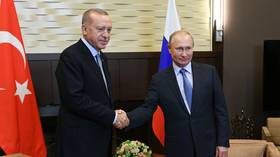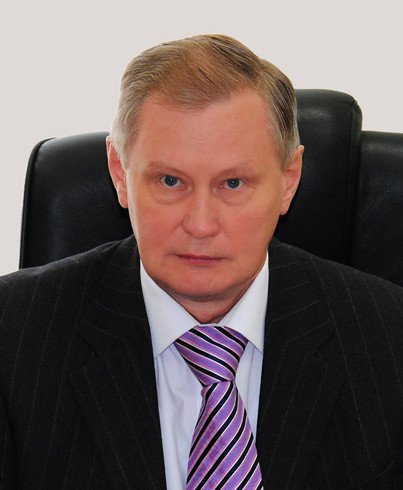How Russia’s military operation in Syria laid groundwork for Erdogan-Putin agreement

Preparations for the events in northeastern Syria began around a year ago. Now, after the US dumped the Kurds, they have no choice but to abide by the Russian-Turkish memorandum.
The Memorandum of Understanding between Turkey and Russia on northern Syria, adopted in Sochi on October 22, put an end to the Turkish offensive against the Syrian Kurds, brought northeast Syria back under the control of Damascus and guaranteed protection of Turkey’s national security interests.
The Turkish-Syrian border is currently split into four stretches specified below in geographical order from east to west.
Here is the full 10-point memorandum between Turkey and Russia: pic.twitter.com/vjEyFlNjTr
— Lucian Kim (@Lucian_Kim) 22 октября 2019 г.
The first stretch is 110 kilometers (68 miles) long and runs from the town of Faysh Khabur through Ayn Divar, Dirwana Agha to Qamishli. Joint Russian-Turkish patrols will be operating in the 10-km wide area adjacent to the border. The 30-km wide area along the state border (including the above-mentioned 10-km stretch) is declared a YPG-free zone where no YPG units or their weapons are allowed.
The second stretch (96km long) runs from Nusaybin through Amuda, Al-Darbasiyah, Faqirah to Al-Metalla. This area will also be patrolled by joint Russian-Turkish troops and is declared a YPG-free zone.
The third stretch (150km long) runs from Aluq Al-Gharbiyah though Ras al-Ayn, Tuwam, al-Ghajir to Tel Abyad. The 32-km wide area along this border stretch (almost down to the M-4 motorway) is where the military Operation Peace Spring was carried out by Turkey’s armed forces.
The fourth stretch (60km long) runs from Aytuwayran Tahtani through Ayn al-Arab (Kobani) to Jarabulus. Just like border areas No. 1 and No. 2, the territories along this stretch of the border will be patrolled by joint Russian and Turkish troops and are declared a YPG-free zone.
Also on rt.com Turks appeased, Kurds saved, US gets breathing space: ‘Russia takes on job that US failed at’ in SyriaTurkey and Russia are now trying to agree on patrol routes, troops and weapons to be used for these missions, as well as patrolling schedules. In addition, a joint monitoring mission will be launched, an effort that will help supervise the process of removing YPG units from the established 30-km YPG-free zone adjacent to the Syrian state border.
It is clear that, at this stage, the Russian military police do not have the resources needed to tackle these new tasks, so Russia plans to increase the number of its military police force by 276 soldiers and officers, forming two additional battalions, and send another 33 pieces of equipment to the area. It also considers deploying the 15th Independent Guards ‘Berlinsky’ Motor Rifle Brigade, which is part of the Russian peacekeeping force.
The German Federal Defense Ministry had previously suggested that peacekeeping activities in the region should be based on the Western coalition forces deployed there. But what exactly does the phrase “based on Western coalition forces” even mean? It seems to suggest that the key role in the peacekeeping mission belongs to the Americans. But in that case the conflict would by no means be resolved – instead, it would be put on ice. And there is a big difference between the two scenarios. All of this can only mean one thing: that from the very beginning, the Western countries did not pin any hopes on the German initiative being successful.
So, the main objective to focus on today is bringing together as many Syrian troops as possible, deploying them all over the area, introducing Russian military police to the zones agreed upon with Turkey and bringing these territories under the control of the civil authorities of the Syrian Arab Republic. In other words, the Syrian flag should be raised over every important town in the liberated territories, and the Syrian-Iraqi border should be patrolled by the Syrian border guards.
Kurds didn’t expect the US to dump them
Now let’s talk briefly about the Kurds. The YPG currently consists of over 120,000 trained soldiers. Until recently, the United States used to supply the Kurds with weapons, ammunition, equipment and other resources. At certain times, the YPG received as many as 1,500 heavy trucks carrying weapons and military equipment per month. The US supplied to the Kurds over 600 Hummers alone. Washington obviously planned to create a quasi-state in the northeast of Syria and use it to foment instability, provoke territorial disputes, stir up violence and bloodshed.
The YPG itself can hardly be considered an actual army, with soldiers ready to fight to the last drop of blood. Its combat capabilities are largely the same as they were during previous Turkish operations, when the Kurds were fighting for Afrin. Defeating the YPG is not at all a difficult task: like they say in the Russian military, they can be crushed “in a snap.” It is a false perception that the Kurds are a powerful force ready to go to war. After the Peace Spring operation started and Turkish troops were deployed in the 30-kilometer zone near the border of Syria, there were no displays of courage or determination on the part of the YPG when it came to defending their land. They had a chance to put up a fight, mine all the roads, blow up the bridges, lay entire minefields or create other obstacles – yet they did none of that.
Also on rt.com ‘America is running away’: Irate Kurds pelt withdrawing US forces with vegetables (VIDEO)Amid all the turmoil of the last couple of years, the Kurds seized a strip of land with several towns in northeast Syria that had never been under their control before, and started smuggling oil in massive quantities. All of that was done under US patronage. In addition to the regular American troops, there were also US private military contractors in Syria, keeping watch over the oil fields.
The Kurds were really counting on the US to remain in the region, but now that the Americans basically ‘dumped’ them, the Kurdish leadership looks like a school of dynamite-stunned fish. Never did they expect to be left hanging out to dry like that.
But life goes on, and now the Kurdish leadership has no choice but to abide by the Russian-Turkish memorandum – all other options are exhausted.
The situation in Syria on the ground
As for the Syrian Army, massive efforts have been made to enhance its military capabilities over the last several years. Today, the Syrian Army is a force to be reckoned with; its 50,000 soldiers and officers are well-trained and ready to fight.
They have been tested in real combat: they are capable, reliable and know how to follow orders. This army relies on the same principle as any other military force: an order from your superior is law. The times when Syrian commanding officers had to be talked into doing their job are long gone. As of today, 1,500 officers of the Syrian Army have undergone training in Russia. On top of that, there are regular competency reviews for commanding officers, and all that don’t pass are immediately kicked out.
Overall, impressive work has been done to restore the combat capabilities of the Syrian Army and prepare it for modern threats and challenges.
America is withdrawing from northeast Syria. However, American troops still remain in some parts of the country. The US retains control over the Al-Omar and Al-Talaka oil fields and local refineries.
Also on rt.com Assad visits frontline in Idlib, vows to retake all of Syrian land (PHOTOS)In light of this, one of the priorities for the Syrian leadership right now is to restore control of the country’s oil fields and start transferring oil through Damascus – instead of sitting idly by while the precious substance is smuggled outside of Syria. This full-on plundering of Syria’s natural resources deprives the legitimate Syrian government of substantial revenues that could otherwise go toward rebuilding the country.
On top of that, the US still controls Al-Tanf in southeast Syria, but since the Rukban camp is about to close, the Americans don’t really have any reason to stay there. To justify its continued presence, the US maintains that its forces sit along a potential weapon and ammunition supply route to Hezbollah. However, there are plenty other roads that could be used for the same purpose – and none of them are under America’s control.
The refugee issue
Refugee camps and prisons for terrorists in northeastern Syria is another issue. We know that in this area, there are eight refugee camps housing 122,200 people and 11 prisons where 14,650 terrorists are held. During Operation Peace Spring, there were a couple of days of panic and anarchy in the Kurdish forces, and about 500 prisoners took advantage of the chaotic situation and escaped. Now these fugitives are trying to either blend in with the locals or find a way to get to Afghanistan or Libya through Iraq.
It would make sense to have a list of everyone currently living in the refugee camps. And then show this list in every country, asking the authorities to claim their citizens and take them home.
The United Nations High Commissioner for Refugees should also be involved in solving the refugee issue. At this point, they don’t need any humanitarian corridors to be able to do that. UN workers can simply come and help, without any restrictions. Many of these refugees are wives and children of terrorists who were killed. We have to figure out how to help them transition back to a normal peaceful life.
Russia’s role
Here is the scope of what Russia should be doing from here on out: continue working with the Kurds, continue working with Damascus, control the Syria-Iraq border by deploying Syrian border patrol units, restore Syrian governing institutions in the liberated regions, and raise Syrian flags. We also need to remember that people are different here. Locals are never in a hurry, and they are not planning on changing the pattern. However, it is very important to act fast in this situation. The people here require some stimulation. There is a lot of work ahead of us.
To sum it up, I can say the following (and I have reasons to believe that I am right).
Four and a half years ago, Russia’s military and political leaders made a decision to launch an operation in Syria. The West did not welcome the move. Well, not everyone in Russia was happy about this decision either. Many referred back to our negative experience in Afghanistan. Some experts cautioned against the operation saying that Russia would just get bogged down in this war. The Syrian operation was also a big challenge for the Russian Armed Forces. It wasn’t clear if our army, air force and navy could handle the truly extraordinary tasks.
Also on rt.com Extra 300 Russian military police arrive in Syria to patrol & ensure Kurdish pulloutWe can ask though – what would’ve happened had the Russian leaders not made this decision? The Turkey-Iran-Israel triangle would surely be engulfed in war by now. Syria as a state would have disappeared from the world map. Hundreds and thousands of heads would be rolling left and right.
It took Russia’s army four years to achieve last week’s success in Syria.
And as for the work in northeastern Syria, preparations began around a year ago. Four months prior to the current events, Russian officers started building connections with the sheikhs of Arab tribes. The US was a major obstacle for this plan, and the main problem was not its presence on the ground, but the airstrikes.
Without any doubt, what we are seeing today is a historic success.
Mikhail Khodarenok, RT.com military analyst, retired colonel.
Think your friends would be interested? Share this story!
The statements, views and opinions expressed in this column are solely those of the author and do not necessarily represent those of RT.















